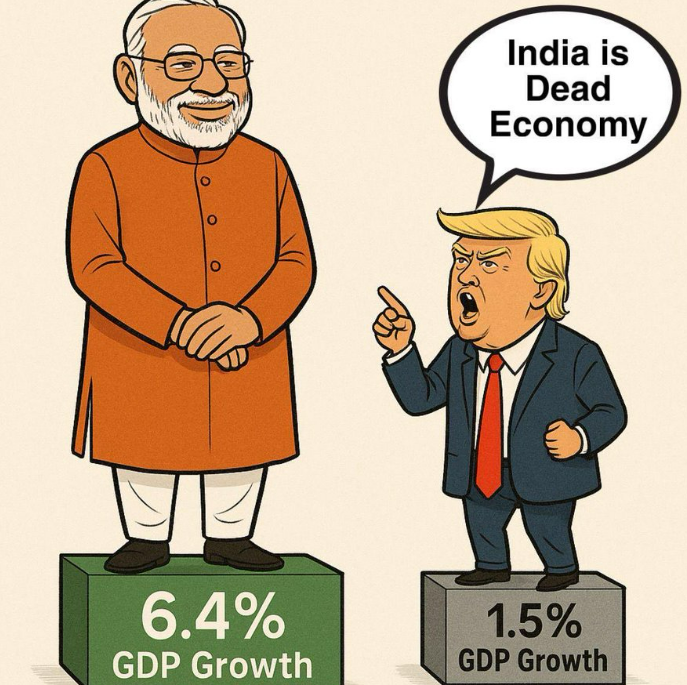Trump Escalates Rhetoric Against India with Tariff Blow
In a 24-hour diplomatic firestorm, Donald Trump launched a sweeping offensive against India, announcing a steep 25% tariff on all Indian goods starting August 1 and referring to India’s economy as “dead” during a scathing rebuke of its ties with Russia. The comments mark a sharp escalation in trade tensions between the two countries and raise questions over the future of their economic and strategic partnership.
The tariff decision was followed by a volatile series of statements from Trump, who accused India of having one of the world’s “most strenuous and obnoxious” trade regimes. “We have done very little business with India, their tariffs are too high,” he said, adding that penalties would also be imposed for New Delhi’s ongoing purchases of Russian crude oil and military hardware.
Absolutely unacceptable language by the US President for India.
The GoI must decide the country’s tipping point for repeated immature baby like rant to bully India to sign a trade deal. pic.twitter.com/tYsk5CiCmx— Priyanka Chaturvedi🇮🇳 (@priyankac19) July 31, 2025
India Responds Cautiously, Studies Implications
India’s Ministry of External Affairs responded with measured diplomacy, saying it had “taken note” of Trump’s remarks and was reviewing the potential impact. “India and the US have been engaged in negotiations on concluding a fair, balanced and mutually beneficial bilateral trade agreement over the last few months. We remain committed to that objective,” the statement read.
The timing of Trump’s tariff declaration came as a surprise, especially given that a U.S. trade delegation was expected to visit India later in August to work out a deal. Analysts see the move as a hardball tactic, aimed at forcing concessions from India ahead of the talks.
Economic Stakes for India Could Be Significant
The United States is India’s largest trading partner, with Indian exports to the U.S. totaling $87.4 billion in 2024. While India is not an export-driven economy like China, the potential damage from Trump’s tariffs could still be considerable.
Economists warn that the 25% duty could shave off between 20 and 50 basis points from India’s GDP growth. Bloomberg Economics has projected that if India retaliates with a 26% levy of its own, outbound shipments to the U.S. could decline by as much as 30%.
Beyond the immediate trade figures, the real danger lies in the broader implications for India’s ambitions to become a global manufacturing hub. “The 25 percent tariff… would undermine India’s attractiveness as an alternative manufacturing hub to China,” said Shilan Shah of Capital Economics. He noted that while India’s high domestic tariffs already make it less competitive than other Asian economies, it still benefits from advantages like low labor costs.
Sectoral Impact: From Jewellery to Machinery
Some of India’s most labor-intensive export sectors are likely to bear the brunt of the new tariffs. Jewellery, textiles, industrial machinery, and seafood exports are expected to face significant disruptions. The jewellery industry, which shipped more than $10 billion worth of goods to the U.S. in 2024, has already warned of widespread job losses, potentially affecting thousands of workers.
Pharmaceuticals and smartphones, two of India’s fastest-growing export segments, appear to be exempt from the initial tariff announcement—at least for now.
Russia Factor: A Longstanding Strategic Tie
Trump’s harsh rhetoric also targeted India’s relationship with Russia, which he implied was incompatible with a strong U.S. partnership. “I don’t care what India does with Russia. They can take their dead economies down together,” he told reporters.
India has historically maintained deep defense and energy ties with Moscow. According to data from the Stockholm International Peace Research Institute, Russia accounted for 76% of India’s defense imports between 2009 and 2013. Although this figure has declined, Russia remains a key supplier of military systems and spare parts.
Moreover, Russia’s crude oil exports to India have surged following sanctions from Western countries over the Ukraine war. India has capitalized on discounted Russian oil, saving billions of dollars even as it faces increasing scrutiny from Western allies.
Uncertain Road Ahead
While Trump’s tariff announcement may be partly aimed at bolstering his tough-on-trade credentials during the U.S. election season, the potential fallout is real. Both nations now face a critical juncture: either engage in meaningful trade dialogue or risk a deepening rift that could reverberate across global markets.
For now, all eyes will be on August 1, when the new tariffs are slated to go into effect—unless diplomatic backchannels find a way to pull both sides back from the brink.








